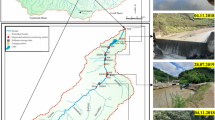Summary
The present investigation was carried out in 1986, and is based upon about 20 years of river discharge data (1960s to 1980s). There are three important river-systems in Nepal - Sapt Kosi River system in East Nepal, Sapt Gandaki River system in mid- Nepal, and Karnali River system in West Nepal. The average annual highest rainfall is 3,685 mm yr−1, and the greatest mean annual suspended sediment load (1.434 g L−1) was recorded in Sapt Gandaki, while the water discharge from Sapt Kosi (1,747 m3 s−1) was the highest and so also was the silt discharge (0.4 million ton day−1). The correlation between water discharge and silt discharge was found to be statistically highly significant as verified by correlation and regression analyses.
An abatement of human interference in the catchment areas of these rivers, and fodder/fuelwood plantation through the active participation of local people in their marginal land to decrease the human pressure on natural forests, are considered the two major easy, effective and economic methods to control the siltation hazard that is causing extensive deterioration to the environment in Nepal.
Similar content being viewed by others
References
Gupta, S.C. and Kapoor, V. 1972.Fundamental of Mathematical Statistics. Sultan Chand and Sons, Delhi, India.
Shankar, K. 1985. Water Resources. In: Majupuria, T.C. (ed.),Nepal Nature's Paradise. White Lotus Company, Bangkok, Thailand.
Sharma, G.P.S. and Uprety, B.K., 1986.Surveillance and Monitoring of River Pollution in Nepal. CEDA, Kathmandu, Nepal.
Zollinger, F. 1979.Analysis of River Problems and Strategy for Flood Control in the Nepalese Terai. IWM/WP/12, Kathmandu, Nepal.
Author information
Authors and Affiliations
Additional information
Dr Govind P.S. Ghimire is Reader and Associate Professor in the Central Department of Botany at Tribhuvan University. Mr B.K. Uprety is an ecologist working on the Environmental Impact Study Project of His Majesty's Government, Nepal.
Rights and permissions
About this article
Cite this article
Ghimire, G.P.S., Uprety, B.K. Causes and effects of siltation on the environment of Nepal. Environmentalist 10, 55–65 (1990). https://doi.org/10.1007/BF02239558
Issue Date:
DOI: https://doi.org/10.1007/BF02239558




